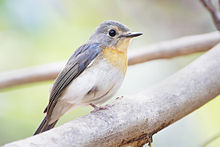- Tickell's Blue Flycatcher
-
Tickell's Blue Flycatcher 
male, Thailand 
female, Thailand Conservation status Scientific classification Kingdom: Animalia Phylum: Chordata Class: Aves Order: Passeriformes Family: Muscicapidae Genus: Cyornis Species: C. tickelliae Binomial name Cyornis tickelliae
Blyth, 1843Synonyms Muscicapa tickelliae
Cyornis tickelli
Muscicapula tickelliaeThe Tickell's Blue Flycatcher (Cyornis tickelliae) is a small passerine bird in the flycatcher family. This is an insectivorous species which breeds in tropical southern Asia from India and Sri Lanka to Indonesia. They are blue on the upperparts and the throat and breast are rufous. They are found in dense scrub to forest habitats.
Contents
Description
The Tickell's Blue Flycatcher is about 11–12 cm long. It sits upright and often forages in the undergrowth. The male has the upperparts dark blue and the throat breast and flanks are orange fading into the buffy white belly. The female is duller blue with a brighter blue brow, shoulder, rump and tail. It hybridizes with the Pale-chinned Flycatcher (Cyornis poliogenys) in the Eastern Ghats of India and these hybrids have sometimes been called the subspecies vernayi. The juvenile is streaked and has a spotted mantle.It is an upright long-tailed flycatcher. The male is a beautiful bird which has bright blue upperparts, a red throat and breast, and the rest of the underparts white.[2]
Females are duller, and the red is reduced in intensity and extent. Juvenile birds have scaly brown upperparts, head and breast, with just the wings and tail being blue. They have sometimes been to feed even after dusk.[3] Apart from flying insects they have been noted to occasionally glean crawling insects.[4]
The widespread species shows regional variations in plumage and size and several of these populations have been designated with subspecies names. The nominate form is found in India, Nepal and Myanmar. The Sri Lankan population is separated as jerdoni (or nesea/mesaea said to be darker[5]) and the population in Thailand and southern Myanmar is named as indochina. Further south is the form sumatrensis (Sumatra Island, Malaysia) and lamprus on Anamba Island.[6][7]
In the past this species has been considered as a subspecies of the Blue-throated Flycatcher (Cyornis rubeculoides) which resembles this but has a blue throat.[8]
Habitat and distribution
The Tickell's Blue Flycatcher breeds in dry forest, scrub, bamboo and gardens.
Behaviour and ecology
The metallic song of the bird includes a series of clicks followed by five or six notes that end abruptly.[5] The metallic song consists of short clicks followed by five or six notes resembling that of the White-browed Fantail-flycatcher. Alarm calls include churr and clicking notes.[2]
They feed mainly by capturing insects in flight but their prey include other insects such as termites and earwigs that may be gleaned or picked from the ground.[9]
The breeding season is April to August (March to June in Sri Lanka). It nests in a hole in a tree or amongst rocks that is lined with fine grass and fibres and lay 3-5 eggs.[10][11][12]
References
- ^ "Cyornis tickelliae". IUCN Red List of Threatened Species. Version 2008. International Union for Conservation of Nature. 2009. http://www.iucnredlist.org/apps/redlist/details/147418. Retrieved 2 January 2010.
- ^ a b Rasmussen, P.C.; and Anderton, J.C. (2005). Birds of South Asia: The Ripley Guide. Volume 2. Smithsonian Institution & Lynx Edicions. pp. 385–387.
- ^ Sharma, S.K. (2006). "Nocturnal feeding by the Tickell's Blue Flycatcher Cyornis tickelliae". Zoos' Print Journal 21 (2): 2171.
- ^ Serrao, J.S. (1964). "Tickell's Blue Flycatcher feeding on crawling prey". Newsletter for Birdwatchers 4 (3): 12. http://www.archive.org/stream/NLBW4#page/n44/mode/1up.
- ^ a b Whistler, Hugh (1949). Popular handbook of Indian birds. London: Gurney and Jackson. pp. 122–124. http://www.archive.org/stream/popularhandbooko033226mbp#page/n159/mode/1up.
- ^ Baker, E. C. Stuart (1924). The Fauna of British India, Including Ceylon and Burma. Birds. Volume 2. London: Taylor and Francis. pp. 234–236. http://www.archive.org/stream/BakerFbiBirds2/bakerFBI2#page/n264/mode/1up.
- ^ Robinson H.C.; and N.B. Kinnear (1928). "Notes on the Genus Cyornis Blyth". Novitates Zoologicae 34: 231–261. http://www.archive.org/stream/novitateszoologi34lond#page/237/mode/1up/.
- ^ Wait, W.E. (1922). "The Passerine birds of Ceylon". Spolia Zeylanica 12: 117–118. http://www.archive.org/stream/passerinebirdsof00wait#page/117/mode/1up.
- ^ D'Abreu, E.A. (1920). Report of the proceedings of the third entomological meeting. Volume 3. Calcutta: Government Press. pp. 859–871. http://www.archive.org/stream/reportofprocee03ento#page/859/mode/1up.
- ^ Abdulali, Humayun (1979). "The nesting of Tickell's Flycatcher (Muscicapa tickelliae) in Bombay". J. Bombay Nat. Hist. Soc. 76 (1): 159–161.
- ^ Hume, A.O. (1890). The nests and eggs of Indian birds. Volume 2. London: R. H. Porter. pp. 7–8. http://www.archive.org/stream/nestseggsofindia02humerich#page/6/mode/2up.
- ^ Oates, E.W. (1903). Catalogue of the collection of birds' eggs in the British Museum. volume 3. London: British Museum. p. 256. http://www.archive.org/stream/catalogueofcolle03brit#page/256/mode/1up/.
External links
- Photos and videos at the Internet Bird Collection
Categories:- IUCN Red List least concern species
- Cyornis
- Birds of Nepal
- Birds of India
- Animals described in 1843
Wikimedia Foundation. 2010.


